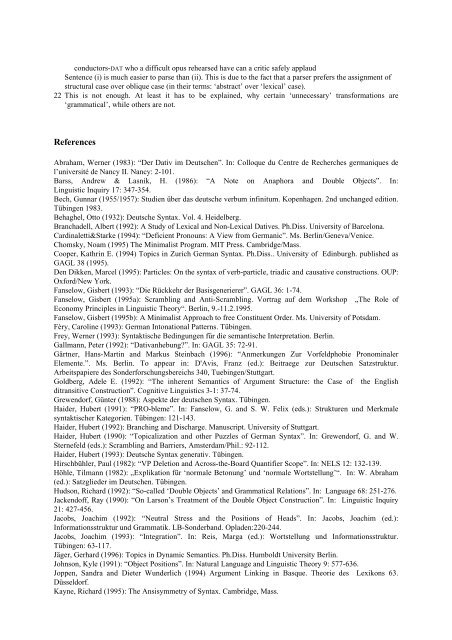The Dative – an Oblique Case
The Dative – an Oblique Case
The Dative – an Oblique Case
Create successful ePaper yourself
Turn your PDF publications into a flip-book with our unique Google optimized e-Paper software.
conductors-DAT who a difficult opus rehearsed have c<strong>an</strong> a critic safely applaud<br />
Sentence (i) is much easier to parse th<strong>an</strong> (ii). This is due to the fact that a parser prefers the assignment of<br />
structural case over oblique case (in their terms: ‘abstract’ over ‘lexical’ case).<br />
22 This is not enough. At least it has to be explained, why certain ‘unnecessary’ tr<strong>an</strong>sformations are<br />
‘grammatical’, while others are not.<br />
References<br />
Abraham, Werner (1983): “Der Dativ im Deutschen”. In: Colloque du Centre de Recherches germ<strong>an</strong>iques de<br />
l’université de N<strong>an</strong>cy II. N<strong>an</strong>cy: 2-101.<br />
Barss, Andrew & Lasnik, H. (1986): “A Note on Anaphora <strong>an</strong>d Double Objects”. In:<br />
Linguistic Inquiry 17: 347-354.<br />
Bech, Gunnar (1955/1957): Studien über das deutsche verbum infinitum. Kopenhagen. 2nd unch<strong>an</strong>ged edition.<br />
Tübingen 1983.<br />
Behaghel, Otto (1932): Deutsche Syntax. Vol. 4. Heidelberg.<br />
Br<strong>an</strong>chadell, Albert (1992): A Study of Lexical <strong>an</strong>d Non-Lexical <strong>Dative</strong>s. Ph.Diss. University of Barcelona.<br />
Cardinaletti&Starke (1994): “Deficient Pronouns: A View from Germ<strong>an</strong>ic”. Ms. Berlin/Geneva/Venice.<br />
Chomsky, Noam (1995) <strong>The</strong> Minimalist Program. MIT Press. Cambridge/Mass.<br />
Cooper, Kathrin E. (1994) Topics in Zurich Germ<strong>an</strong> Syntax. Ph.Diss.. University of Edinburgh. published as<br />
GAGL 38 (1995).<br />
Den Dikken, Marcel (1995): Particles: On the syntax of verb-particle, triadic <strong>an</strong>d causative constructions. OUP:<br />
Oxford/New York.<br />
F<strong>an</strong>selow, Gisbert (1993): “Die Rückkehr der Basisgenerierer”. GAGL 36: 1-74.<br />
F<strong>an</strong>selow, Gisbert (1995a): Scrambling <strong>an</strong>d Anti-Scrambling. Vortrag auf dem Workshop „<strong>The</strong> Role of<br />
Economy Principles in Linguistic <strong>The</strong>ory“. Berlin, 9.-11.2.1995.<br />
F<strong>an</strong>selow, Gisbert (1995b): A Minimalist Approach to free Constituent Order. Ms. University of Potsdam.<br />
Fèry, Caroline (1993): Germ<strong>an</strong> Intonational Patterns. Tübingen.<br />
Frey, Werner (1993): Syntaktische Bedingungen für die sem<strong>an</strong>tische Interpretation. Berlin.<br />
Gallm<strong>an</strong>n, Peter (1992): “Dativ<strong>an</strong>hebung?”. In: GAGL 35: 72-91.<br />
Gärtner, H<strong>an</strong>s-Martin <strong>an</strong>d Markus Steinbach (1996): “Anmerkungen Zur Vorfeldphobie Pronominaler<br />
Elemente.”. Ms. Berlin. To appear in: D'Avis, Fr<strong>an</strong>z (ed.): Beitraege zur Deutschen Satzstruktur.<br />
Arbeitspapiere des Sonderforschungsbereichs 340, Tuebingen/Stuttgart.<br />
Goldberg, Adele E. (1992): “<strong>The</strong> inherent Sem<strong>an</strong>tics of Argument Structure: the <strong>Case</strong> of the English<br />
ditr<strong>an</strong>sitive Construction”. Cognitive Linguistics 3-1: 37-74.<br />
Grewendorf, Günter (1988): Aspekte der deutschen Syntax. Tübingen.<br />
Haider, Hubert (1991): “PRO-bleme”. In: F<strong>an</strong>selow, G. <strong>an</strong>d S. W. Felix (eds.): Strukturen und Merkmale<br />
syntaktischer Kategorien. Tübingen: 121-143.<br />
Haider, Hubert (1992): Br<strong>an</strong>ching <strong>an</strong>d Discharge. M<strong>an</strong>uscript. University of Stuttgart.<br />
Haider, Hubert (1990): “Topicalization <strong>an</strong>d other Puzzles of Germ<strong>an</strong> Syntax”. In: Grewendorf, G. <strong>an</strong>d W.<br />
Sternefeld (eds.): Scrambling <strong>an</strong>d Barriers, Amsterdam/Phil.: 92-112.<br />
Haider, Hubert (1993): Deutsche Syntax generativ. Tübingen.<br />
Hirschbühler, Paul (1982): “VP Deletion <strong>an</strong>d Across-the-Board Qu<strong>an</strong>tifier Scope”. In: NELS 12: 132-139.<br />
Höhle, Tilm<strong>an</strong>n (1982): „Explikation für ‘normale Betonung’ und ‘normale Wortstellung’“. In: W. Abraham<br />
(ed.): Satzglieder im Deutschen. Tübingen.<br />
Hudson, Richard (1992): “So-called ‘Double Objects’ <strong>an</strong>d Grammatical Relations”. In: L<strong>an</strong>guage 68: 251-276.<br />
Jackendoff, Ray (1990): “On Larson’s Treatment of the Double Object Construction”. In: Linguistic Inquiry<br />
21: 427-456.<br />
Jacobs, Joachim (1992): “Neutral Stress <strong>an</strong>d the Positions of Heads”. In: Jacobs, Joachim (ed.):<br />
Informationsstruktur und Grammatik. LB-Sonderb<strong>an</strong>d. Opladen:220-244.<br />
Jacobs, Joachim (1993): “Integration”. In: Reis, Marga (ed.): Wortstellung und Informationsstruktur.<br />
Tübingen: 63-117.<br />
Jäger, Gerhard (1996): Topics in Dynamic Sem<strong>an</strong>tics. Ph.Diss. Humboldt University Berlin.<br />
Johnson, Kyle (1991): “Object Positions”. In: Natural L<strong>an</strong>guage <strong>an</strong>d Linguistic <strong>The</strong>ory 9: 577-636.<br />
Joppen, S<strong>an</strong>dra <strong>an</strong>d Dieter Wunderlich (1994) Argument Linking in Basque. <strong>The</strong>orie des Lexikons 63.<br />
Düsseldorf.<br />
Kayne, Richard (1995): <strong>The</strong> Ansisymmetry of Syntax. Cambridge, Mass.

















